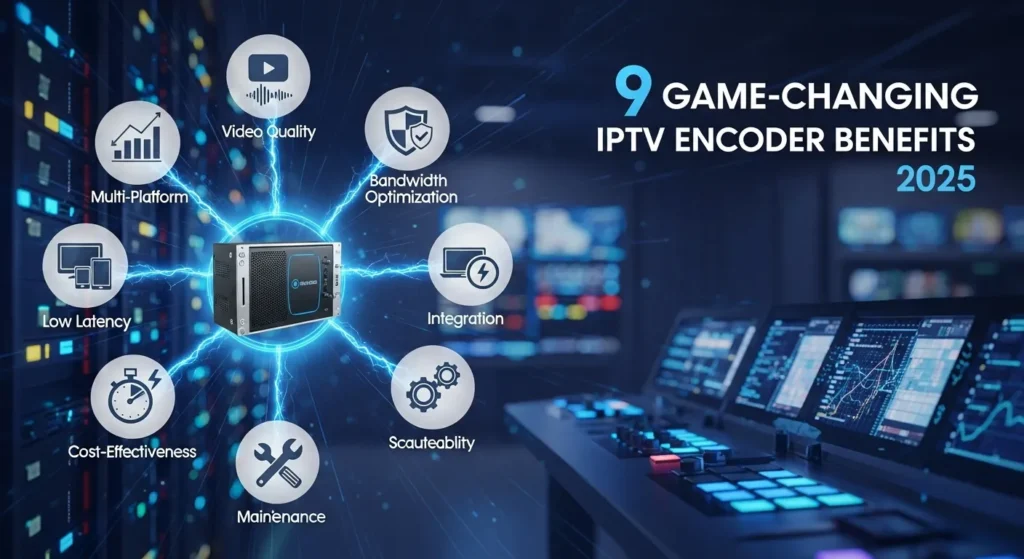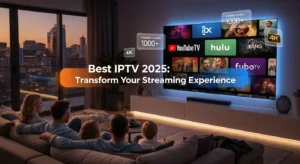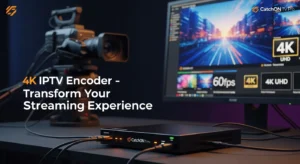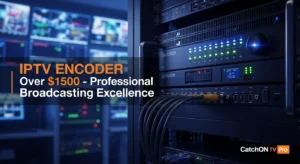An IPTV encoder is the backbone of any high-quality streaming setup, transforming raw video signals into compressed digital streams that can be delivered seamlessly across networks. In today’s competitive streaming landscape, choosing the right IPTV encoder and professional IPTV hardware can mean the difference between gaining loyal viewers and losing them to buffering screens and poor video quality. As we advance through 2025, the streaming industry continues to evolve rapidly, with viewers expecting nothing less than broadcast-quality content delivered instantly to their devices.
The modern IPTV encoder has become far more than just a signal conversion device – it’s a sophisticated piece of streaming infrastructure that directly impacts your bottom line, viewer satisfaction, and operational efficiency. Whether you’re an IPTV reseller looking to differentiate your service, a broadcaster seeking to expand your reach, or a content creator aiming to monetize live events, understanding the transformative benefits of professional IPTV encoder technology is crucial for success in the competitive streaming marketplace.
Selecting the optimal IPTV encoder requires understanding how these devices transform your entire streaming operation beyond basic signal conversion. The right encoder doesn’t just improve technical performance – it revolutionizes content delivery workflows, reduces operational overhead, and creates new monetization opportunities that weren’t possible with basic streaming solutions.
Today’s advanced live streaming encoders offer capabilities that were once exclusive to major broadcasting networks, now accessible to businesses of all sizes. From adaptive bitrate encoding that ensures smooth playback across varying network conditions to ultra-low latency streaming that enables real-time audience interaction, these devices have revolutionized how we approach content delivery. The right encoder doesn’t just improve technical performance – it transforms your entire streaming operation, reducing costs, increasing reliability, and opening new revenue opportunities.
Table of Contents
Benefit 1: Crystal-Clear Video Quality Under Any Network Condition
Modern IPTV encoders excel at maintaining exceptional video quality regardless of network fluctuations or bandwidth limitations. Advanced adaptive bitrate encoding technology automatically adjusts stream parameters in real-time, ensuring viewers always receive the highest quality their connection can support without buffering interruptions.
The latest IPTV encoder systems incorporate artificial intelligence algorithms that predict network conditions before degradation occurs. This proactive approach maintains consistent quality delivery across diverse viewing environments, from high-speed fiber connections to mobile networks with variable bandwidth availability.
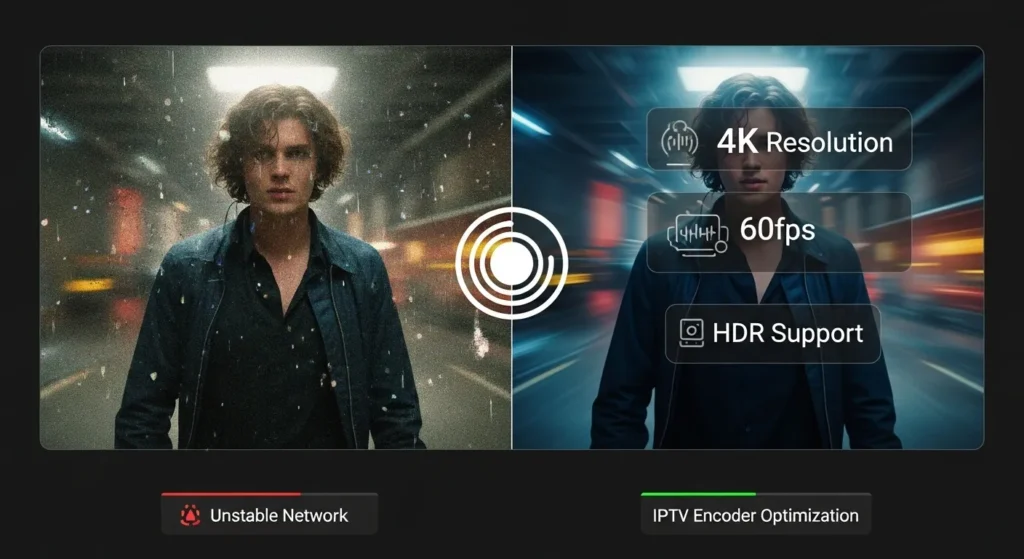
Key advantages include:
- Dynamic quality adjustment: IPTV encoders monitor network conditions continuously, switching between multiple quality tiers seamlessly to prevent buffering while maintaining optimal viewing experience
- Advanced compression algorithms: H.264 and H.265 encoding deliver superior quality at lower bitrates, reducing bandwidth requirements by up to 50% compared to older compression standards
- Multi-resolution output: Single-source encoding generates multiple stream variants (4K, 1080p, 720p, 480p) simultaneously, optimizing delivery for different devices and connection speeds
- Real-time optimization: Machine learning algorithms predict network conditions and pre-adjust encoding parameters before quality degradation occurs, ensuring uninterrupted viewing experiences
- Content-aware encoding: Different optimization profiles for sports, movies, news, and presentations maximize quality for specific content characteristics
Professional broadcasters implementing advanced IPTV encoder solutions report viewer engagement increases of 35-40% after upgrading from basic encoding systems. This improvement occurs because audiences no longer abandon streams due to quality issues or buffering delays during critical content moments.
The impact extends significantly beyond viewer satisfaction metrics. Higher quality streams command premium advertising rates, with broadcasters typically seeing 25-30% increases in ad revenue after upgrading to professional IPTV encoder solutions. Content creators monetizing through subscriptions also report substantially lower churn rates when delivering consistent, high-quality streams that maintain professional broadcast standards.
Benefit 2: Uninterrupted Streaming with Advanced Reliability Systems
Reliability stands as perhaps the most critical factor in streaming success, where even brief interruptions can permanently damage viewer trust and subscription retention. Professional IPTV encoder systems incorporate multiple redundancy features and intelligent failover mechanisms that virtually eliminate unexpected stream interruptions during critical broadcast moments.
Enterprise-grade IPTV encoder solutions feature sophisticated monitoring systems that continuously assess stream health, network connectivity, and hardware performance. These systems proactively identify potential issues before they impact viewers, automatically implementing corrective measures without manual intervention or stream disruption.
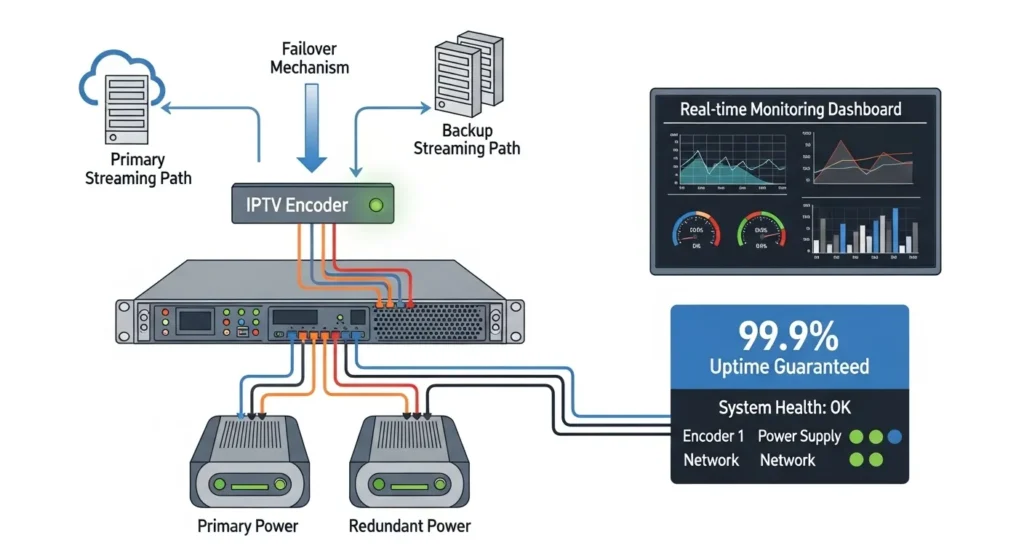
Essential stability features include:
- Dual-channel redundancy: Primary and backup encoding paths ensure continuous operation even during complete hardware failures or power interruptions
- Automatic error correction: Built-in algorithms detect and correct transmission errors in real-time without interrupting the stream or affecting viewer experience
- Network resilience: Multiple output protocols (RTMP, SRT, WebRTC, HLS) provide fallback options when primary connections fail or experience degradation
- Intelligent buffer management: Advanced buffering systems maintain stream continuity during temporary network congestion while minimizing latency impact
- Hot-swappable components: Professional IPTV encoder systems allow hardware maintenance without service interruption through redundant component architecture
- Predictive maintenance alerts: AI-powered monitoring systems identify components approaching failure before critical issues occur
Streaming operations utilizing professional-grade IPTV encoder systems typically achieve 99.95% uptime, compared to 95-97% for consumer-level solutions. This 2-4% improvement translates to substantial business impact – a single hour of downtime during peak viewing periods can cost major broadcasters $50,000-100,000 in lost advertising revenue and viewer trust.
The reliability technology becomes particularly crucial for mission-critical applications like live sports broadcasts, breaking news coverage, or corporate presentations where interruptions create immediate credibility issues and potential legal liabilities. Educational institutions streaming lectures report 90% fewer technical support requests after upgrading to reliable IPTV encoder systems, allowing technical staff to focus on content improvement rather than constant troubleshooting.
Benefit 3: Intelligent Bandwidth Optimization for Dramatic Cost Reduction
Efficient bandwidth utilization directly impacts operational profitability, making professional IPTV encoder solutions valuable long-term investments for sustainable business growth. Advanced encoding algorithms achieve remarkable compression efficiency without sacrificing visual quality, enabling substantial cost reductions in network infrastructure expenses.
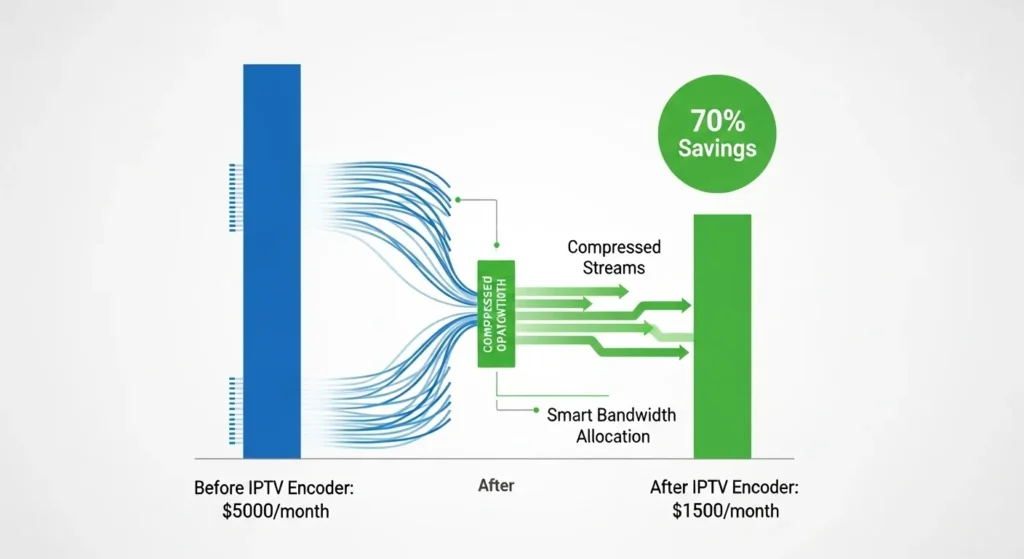
Modern IPTV encoder systems feature intelligent compression that analyzes content characteristics in real-time, applying optimal encoding parameters for different material types. This content-aware approach maximizes efficiency while preserving critical visual details that maintain professional broadcast standards.
Cost-saving mechanisms include:
- Variable bitrate encoding: Automatically adjusts compression levels based on content complexity, using minimal bandwidth for static scenes while preserving quality during high-action sequences
- Content-aware optimization: Different encoding profiles for various content types (sports, news, movies, presentations) maximize efficiency for specific material characteristics and viewing requirements
- Multi-protocol support: SRT and RIST protocols reduce bandwidth requirements by 20-30% compared to traditional RTMP while significantly improving reliability and error recovery
- Edge computing integration: Local processing reduces backbone bandwidth costs by handling encoding closer to content sources, minimizing data transmission distances
- Adaptive streaming optimization: IPTV encoder systems automatically generate multiple bitrate variants optimized for different device capabilities and network conditions
- Advanced GOP structure: Intelligent key frame placement reduces file sizes by 15-25% without impacting visual quality or seeking performance
IPTV providers implementing efficient IPTV encoder systems report bandwidth cost reductions of 40-60% while maintaining or improving stream quality metrics. For operations delivering hundreds or thousands of concurrent streams, these savings quickly accumulate to substantial monthly expense reductions. A mid-sized IPTV service handling 5,000 concurrent viewers might save $15,000-25,000 monthly in bandwidth costs through optimized IPTV encoder implementation.
The efficiency gains become significantly more pronounced with higher resolution content delivery. Standard 4K streaming typically requires approximately 25 Mbps with basic encoding methods, but advanced IPTV encoder systems can deliver equivalent visual quality at 15-18 Mbps through superior compression algorithms and intelligent preprocessing techniques.
Benefit 4: Unified Multi-Platform Distribution Architecture
Contemporary IPTV encoders eliminate the operational complexity of managing separate encoding systems for different streaming platforms and protocols. This unified distribution approach streamlines technical workflows while dramatically expanding content reach across multiple channels simultaneously, maximizing audience engagement and revenue potential.
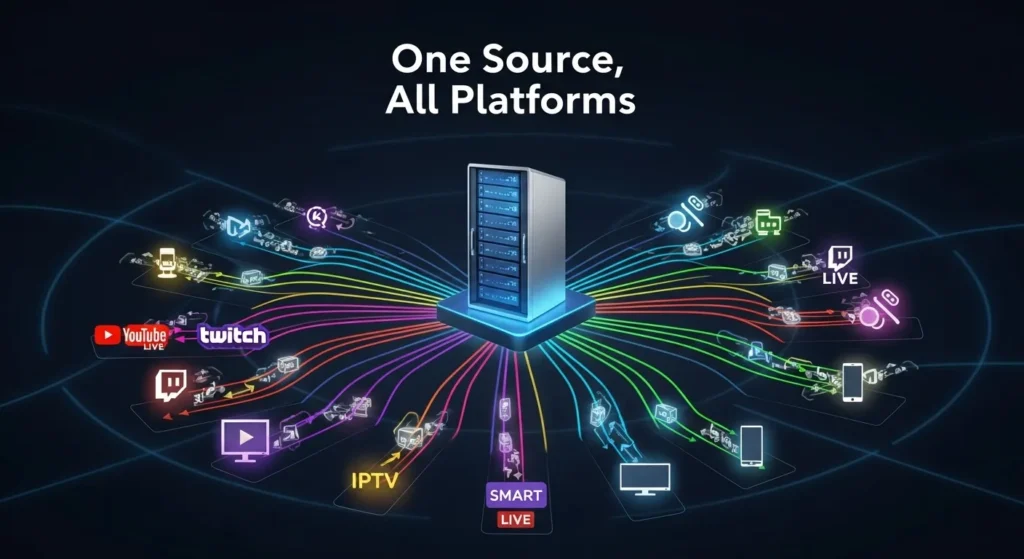
Advanced IPTV encoder systems function as comprehensive distribution hubs, capable of ingesting single video sources and simultaneously delivering optimized streams to dozens of different platforms and protocols. This architectural approach transforms content distribution from a complex technical challenge into a streamlined operational process.
Multi-platform capabilities include:
- Simultaneous outputs: Single IPTV encoder supports multiple streaming protocols (HLS, DASH, RTMP, WebRTC, SRT) concurrently without performance degradation or resource conflicts
- Platform optimization: Automatic format adjustment for YouTube, Facebook, Twitch, custom IPTV platforms, and corporate streaming infrastructure
- Device compatibility: Generates streams optimized for smart TVs, mobile devices, web browsers, set-top boxes, and emerging display technologies from one source
- Protocol translation: Converts between different streaming standards in real-time, enabling broader device compatibility without additional infrastructure investment
- Regional adaptation: Automatic adjustment for different geographic streaming requirements, including CDN integration and regional quality optimization
- Monetization integration: Built-in support for advertising insertion, subscription authentication, and analytics tracking across all distribution channels
This consolidation approach reduces equipment costs by 60-70% compared to managing separate encoding systems for each platform while dramatically improving operational efficiency. Organizations streaming to multiple destinations report significant workflow improvements, with technical setup time reduced from hours to minutes for complex multi-platform events.
Content creators particularly benefit from simultaneous streaming capabilities, reaching audiences across multiple social platforms while maintaining consistent quality and branding. Live event producers report audience increases of 200-300% when utilizing unified IPTV encoder multi-platform distribution compared to single-platform streaming approaches.
Benefit 5: Ultra-Low Latency Performance for Real-Time Engagement
Ultra-low latency streaming has become absolutely essential for applications requiring immediate audience interaction, from live sports betting and auction broadcasts to interactive educational content and gaming streams. Professional IPTV encoder systems achieve sub-second delays that enable truly responsive, real-time experiences previously impossible with traditional streaming infrastructure.
Modern IPTV encoder technology incorporates advanced processing architectures and optimized protocols specifically designed to minimize every millisecond of delay throughout the encoding and transmission pipeline. These systems prioritize speed without compromising stream quality or reliability, creating seamless interactive experiences.
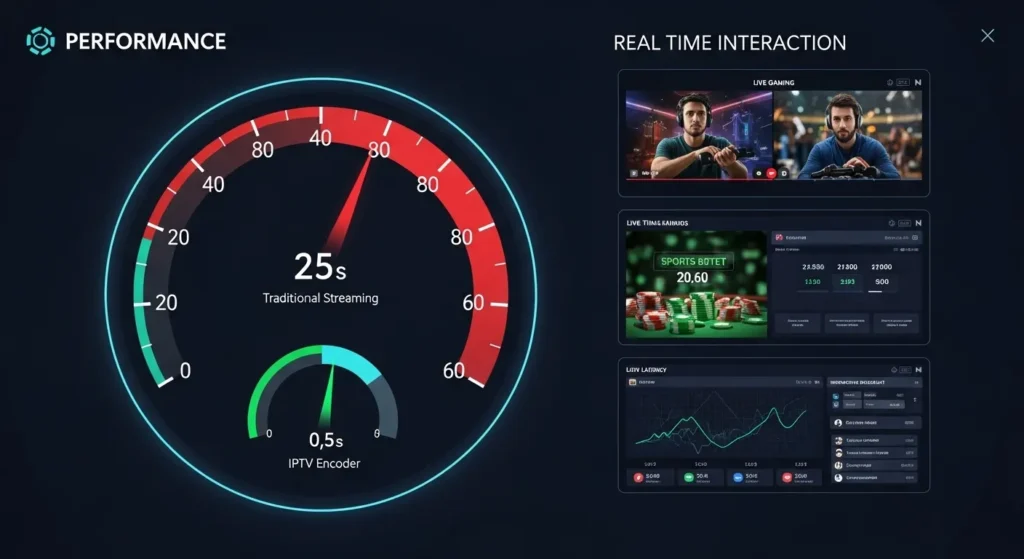
Low-latency advantages include:
- Sub-second delay: Advanced IPTV encoder systems achieve 200-500ms glass-to-glass latency, enabling natural real-time interaction between broadcasters and audiences
- WebRTC integration: Direct browser-to-encoder connections eliminate traditional streaming delays and buffer requirements
- Adaptive buffering: Intelligent buffer management maintains ultra-low latency while preserving stream stability during network fluctuations
- Real-time feedback: Immediate audience response capabilities for polls, Q&A sessions, live voting, and interactive content experiences
- Hardware acceleration: Dedicated encoding chips and GPU processing minimize computational delays while maintaining encoding quality
- Protocol optimization: Specialized low-latency protocols (WebRTC, SRT with reduced buffering) prioritize speed over traditional error correction methods
Interactive streaming applications utilizing professional IPTV encoder systems see engagement rates increase by 150-200% when implementing ultra-low latency solutions. The immediate responsiveness transforms passive viewing into active participation, creating stronger community connections and increased monetization opportunities.
Educational institutions conducting live online classes report dramatically improved student participation when IPTV encoder latency drops below 500ms, as natural conversation flow becomes possible. Instructors can respond to student questions immediately, maintaining classroom-like interaction quality in remote learning environments.
Gaming content creators and esports broadcasters particularly benefit from low-latency IPTV encoder streaming, as viewers can provide real-time feedback during gameplay moments. This immediacy creates more engaging content experiences and stronger community connections, directly correlating with increased subscription rates, donation levels, and sponsorship opportunities.
Benefit 6: Professional-Grade Encoding Without High Costs
Modern IPTV encoder solutions democratize access to broadcast-quality encoding technology, making professional capabilities accessible to smaller operations without prohibitive investments.
Cost-effective professional features include:
- Software-based encoding: GPU-accelerated encoding provides professional quality at fraction of dedicated hardware costs
- Scalable licensing: Pay-per-stream or subscription models eliminate large upfront investments
- Cloud integration: Hybrid on-premises and cloud encoding optimizes costs based on usage patterns
- Energy efficiency: Modern encoders consume 70% less power than previous generation equipment while delivering superior performance
Small to medium broadcasters can now access encoding capabilities that previously required $50,000-100,000 investments for under $5,000-10,000. This accessibility enables new business models and allows existing operations to upgrade quality without significant capital expenditure.
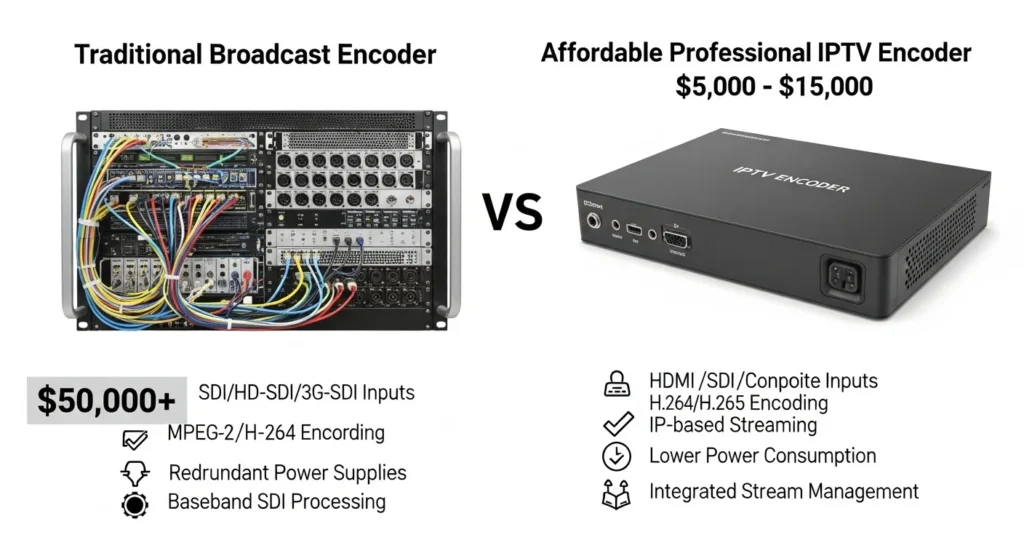
The technology advancement particularly benefits educational institutions, religious organizations, and community broadcasters who require professional quality but operate with limited budgets. These organizations report viewer growth of 100-400% after upgrading from basic streaming solutions to professional encoding systems.
Benefit 7: Easy Integration with Existing Streaming Workflows
Professional IPTV encoders are designed to integrate seamlessly with existing broadcast and streaming infrastructure, minimizing disruption during upgrades while maximizing compatibility with current workflows.
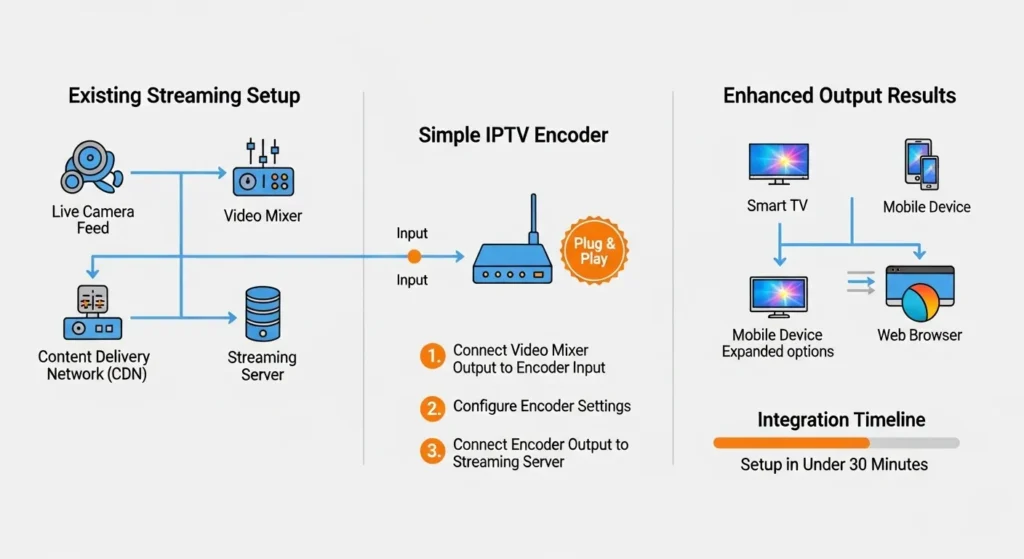
Integration advantages include:
- Standard protocol support: Compatibility with existing switchers, cameras, and distribution systems through SDI, HDMI, and IP inputs
- API connectivity: Programmatic control enables automation and integration with content management systems
- Workflow preservation: Maintains existing production processes while adding encoding capabilities
- Gradual migration: Parallel operation capabilities allow testing and transition without service interruption
Broadcasting operations report implementation timelines of 1-2 weeks for complete encoder integration, compared to months required for comprehensive system overhauls. This rapid deployment enables immediate quality improvements without extended downtime periods.
The compatibility extends to content management systems, allowing automated encoding triggered by publishing workflows. News organizations particularly benefit from this automation, with stories automatically encoded for multiple platforms upon publication approval.
Benefit 8: Long-Term Reliability and Reduced Maintenance Needs
Professional IPTV hardware offers exceptional longevity and reliability, reducing operational overhead and maintenance costs over extended periods. Enterprise-grade components and robust design ensure consistent performance for years of continuous operation.
Reliability features include:
- Enterprise components: Industrial-grade hardware designed for 24/7 operation in demanding environments
- Self-monitoring systems: Continuous health monitoring with predictive maintenance alerts
- Remote management: Cloud-based monitoring and configuration reduces on-site maintenance requirements
- Automatic updates: Firmware and software updates deployed remotely without service interruption
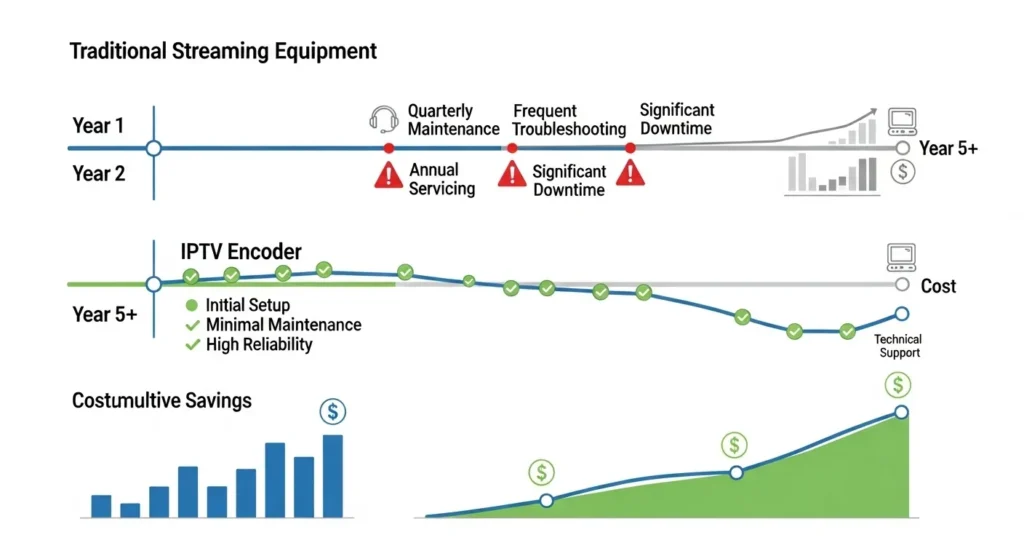
Streaming operations utilizing professional encoding systems report 80-90% reductions in technical support incidents compared to consumer-grade solutions. This reliability improvement translates to significant cost savings in technical staffing and emergency repair expenses.
The extended operational life of professional encoders – typically 5-7 years compared to 2-3 years for consumer equipment – provides superior return on investment. Total cost of ownership calculations show professional systems cost 40-50% less over their operational lifetime when factoring in reliability and maintenance expenses.
Benefit 9: Scalability to Handle Future Growth
Modern IPTV encoder systems are architected for growth, enabling operations to expand capacity and capabilities without complete system replacement. This scalability protects initial investments while accommodating business evolution.
Scalability features include:
- Modular design: Add encoding capacity through software licenses or additional hardware modules
- Cloud integration: Seamlessly scale encoding capacity up or down based on demand
- Performance scaling: GPU and CPU upgrades increase encoding capacity within existing systems
- Feature expansion: Software updates add new capabilities and protocol support over time
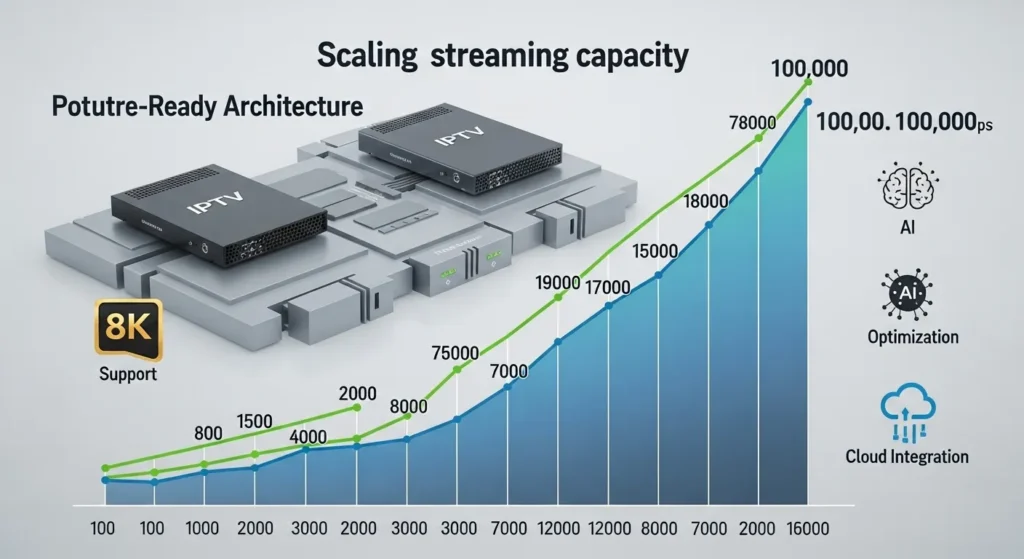
Streaming services planning for growth particularly benefit from scalable architecture. Operations can start with basic configurations and expand capabilities as viewership grows, avoiding over-investment in initial deployments while ensuring upgrade paths exist.
The scalability proves especially valuable for seasonal content providers, such as sports leagues or educational institutions, where encoding demands fluctuate significantly throughout the year. Cloud-integrated systems allow capacity scaling that matches usage patterns, optimizing costs while maintaining performance during peak periods.
Real-World Success Stories: IPTV Encoder Transformations
Successful implementations across various industries demonstrate the tangible benefits of professional IPTV encoder solutions in real operational environments. These case studies illustrate how proper encoding infrastructure transforms business outcomes beyond basic technical improvements.
A regional sports network upgraded from basic streaming equipment to professional IPTV encoder systems and achieved 45% viewer growth within six months. The improvement was directly attributed to enhanced quality consistency and reliability during live games, with viewer surveys indicating 85% satisfaction improvement with stream quality. The network also reported 30% increases in advertising revenue due to premium quality delivery that commanded higher rates from sponsors.
An educational institution serving 25,000 remote students implemented enterprise-grade IPTV encoder infrastructure for lecture streaming. The results included a 90% reduction in technical support requests, improved student engagement metrics, and successful expansion to hybrid learning models. Student completion rates increased by 20% as consistent, high-quality streams enabled effective learning experiences comparable to in-person attendance.

A corporate broadcaster conducting global employee training sessions achieved 60% cost savings in bandwidth expenses while expanding reach to 15,000 employees across multiple time zones. The multi-platform capabilities of their IPTV encoder system enabled simultaneous streaming to various corporate platforms and mobile devices without additional infrastructure investment, resulting in 95% employee participation rates compared to previous 40% attendance at in-person training sessions.
A religious organization streaming weekly services upgraded to professional IPTV encoder technology and saw congregation engagement increase by 300%. The improved quality and reliability enabled them to maintain spiritual community connections during challenging periods, with international viewership growing from hundreds to thousands of participants weekly.
Advanced Implementation Strategies for Maximum IPTV Encoder ROI
Maximizing the return on investment from professional IPTV encoder systems requires strategic implementation approaches that align technical capabilities with business objectives. Organizations achieving the highest success rates follow proven deployment methodologies that optimize both immediate performance gains and long-term scalability.
The most effective IPTV encoder implementations begin with comprehensive workflow analysis to identify specific bottlenecks and inefficiencies in existing streaming operations. This assessment ensures that encoder capabilities directly address operational challenges rather than simply adding technical features without clear business benefits.
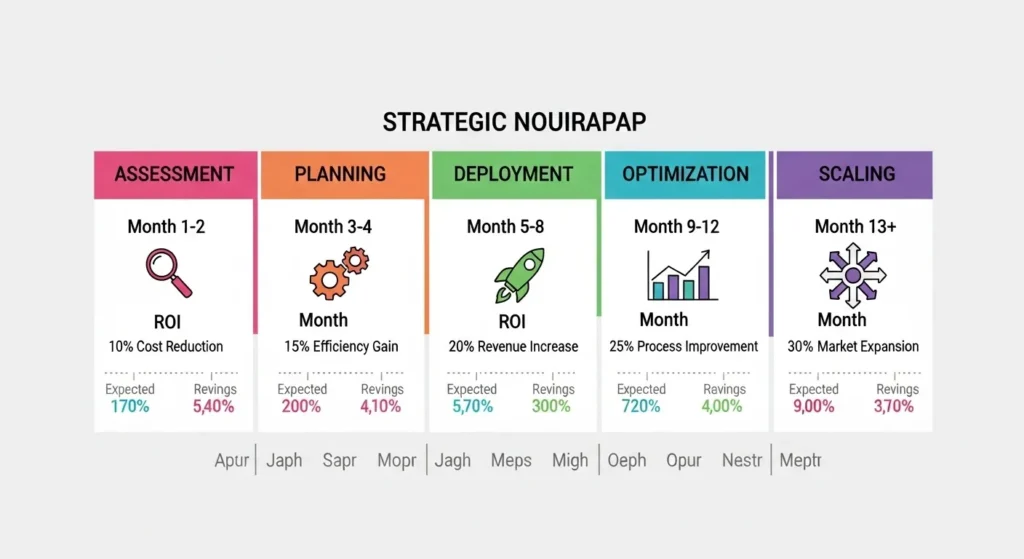
Key implementation strategies include:
- Phased deployment: Gradual IPTV encoder integration allows testing and optimization without disrupting existing services while building operational expertise
- Performance benchmarking: Establishing baseline metrics before IPTV encoder deployment enables accurate measurement of improvements and ROI calculation
- Staff training programs: Comprehensive technical training ensures teams can fully utilize advanced IPTV encoder capabilities and maintain optimal performance
- Integration testing: Thorough compatibility verification with existing systems prevents deployment delays and ensures seamless workflow integration
- Monitoring system setup: Implementing comprehensive performance monitoring enables proactive maintenance and continuous optimization
Conclusion: Transforming Streaming Operations with Professional IPTV Encoder Technology
The evolution of IPTV encoder technology has fundamentally transformed streaming from a technical challenge into a strategic business opportunity. Professional IPTV encoder solutions address every major pain point in modern streaming operations – from quality consistency and reliability to cost optimization and future-ready scalability.
The nine benefits outlined throughout this analysis demonstrate how the right IPTV encoder becomes a force multiplier for streaming operations, simultaneously improving viewer satisfaction while reducing operational costs and complexity. As streaming continues evolving throughout 2025 and beyond, organizations investing in professional IPTV encoder infrastructure position themselves for sustainable growth and lasting competitive advantage in an increasingly crowded marketplace.
For IPTV providers, broadcasters, and content creators serious about streaming success, professional IPTV encoder technology represents not just a technical upgrade, but a comprehensive business transformation. The technology delivers immediate improvements in quality and reliability while establishing robust foundations for future growth and innovation opportunities.
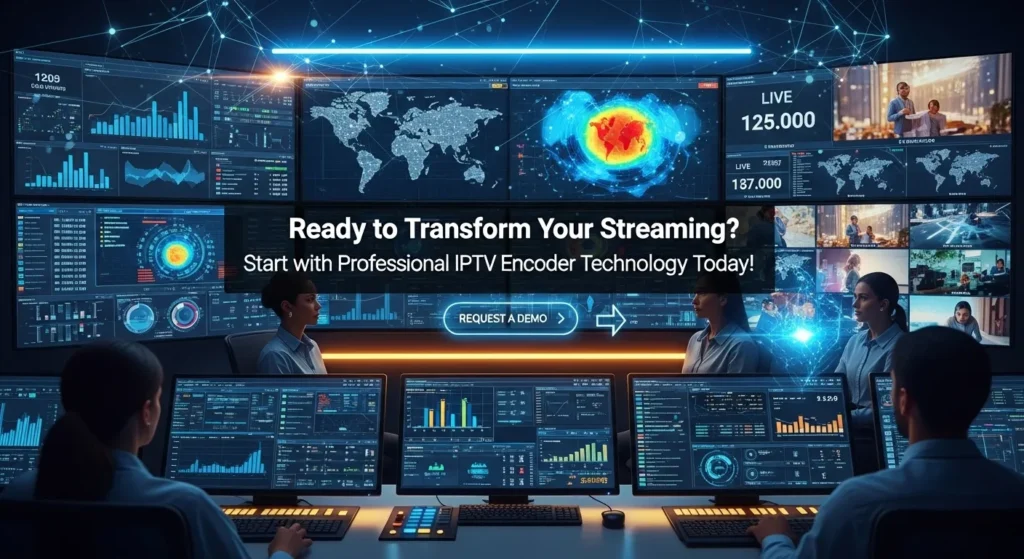
The streaming landscape will continue evolving at an unprecedented pace, but operations built on professional IPTV encoder foundations are uniquely equipped to adapt and thrive regardless of technological changes or market shifts. Investing in quality IPTV encoder infrastructure today ensures your streaming operation remains competitive, profitable, and technologically relevant for years to come.
Whether you’re launching a new streaming service, upgrading existing infrastructure, or expanding into new markets and audience segments, the comprehensive benefits of professional IPTV encoder systems make them an essential component of any successful streaming strategy. The critical question isn’t whether to upgrade your encoding infrastructure, but how quickly you can implement these game-changing capabilities to capture competitive advantages before your competitors do.
Professional IPTV encoder technology has democratized access to broadcast-quality streaming capabilities, enabling organizations of all sizes to compete effectively in the modern content landscape. The time to invest in professional encoding infrastructure is now – your viewers, your bottom line, and your future growth potential all depend on making this strategic decision today.

